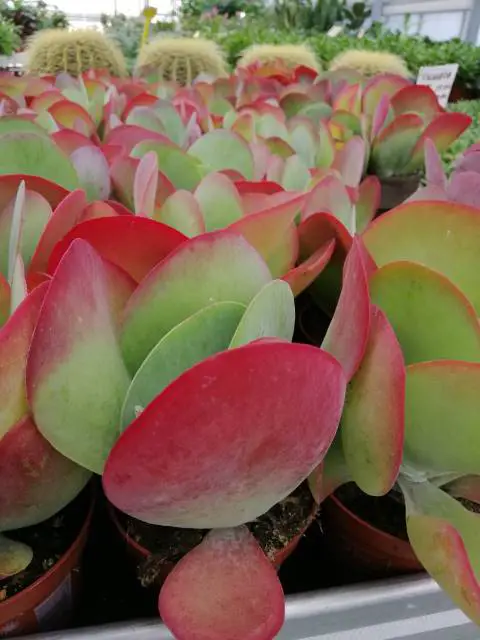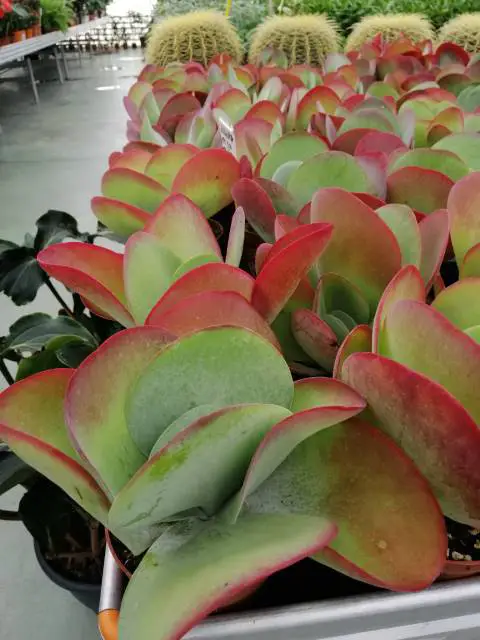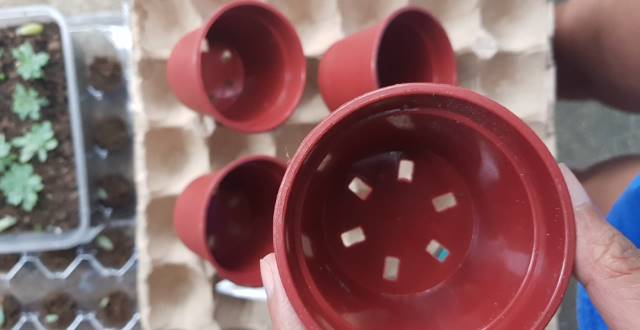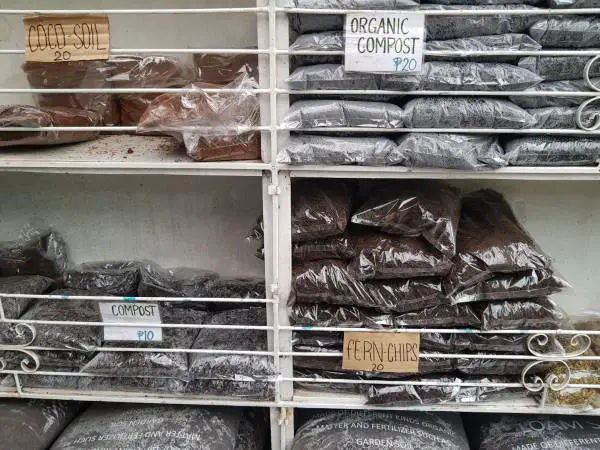Kalanchoe luciae is an evergreen, eye-catching dramatic succulent that belongs to the family Crassulaceae. The succulent has smooth flat leaves that blush an amazing red color when exposed to the right amount of sunshine. Paddle plant is monocarpic (the main rosette dies after flowering) and can be easily propagated from offsets
Due to its dramatic appearance, Kalanchoe luciae has been also awarded the ‘Award of the Garden Merit’ of the Royal Horticultural Society.
Common Name: Paddle Plant, Flapjack Kalanchoe, Paddle Kalanchoe, Desert Cabbage, Red Pancakes, Flipping pancakes.
Synonyms: Kalanchoe aleuroides, Kalanchoe albiflora
Origin
Kalanchoe luciae is originated from South Africa, Mozambique, Zimbabwe, and Swaziland.
Characteristics
Kalanchoe luciae has an attractive appearance and grows up to 2 feet (60 cm) tall. It has grey-green to yellowish-green leaves with red edges. The succulent has a basal rosette of rounded, thick, fleshy leaves. The leaves are up to 6 inches (15 cm) long and 4 inches (10 cm) wide. In some cases when the winter temperature is cool, the leaves may turn a vibrant red. The flowers appear in clusters.

They are urn-shaped, pinkish, white, pale-greenish white, creamy, or yellowish. The succulent is monocarpic, the main rosette dies after flowering to encourage the growth of fresh offshoots.
Blooming season
The blooming season of Kalanchoe luciae is usually from early spring to late winter.
How Kalanchoe luciae can be differentiated from Kalanchoe thyrsiflora?
Kalanchoe luciae is quite close in resemblance to Kalanchoe thyrsiflora. They can be easily confused with each other. Kalanchoe thyrsiflora has shorter and broad leaves and does not turn red in winter. Unlike Kalanchoe luciae, Kalanchoe thyrsiflora has darker yellow and sweetly scented flowers.
How to Grow and Care for Kalanchoe luciae?
Paddle plant is very easy to care for. The succulent is highly forgetting in nature and doesn’t require a lot of care. Keep reading to know how to care for Kalanchoe luciae.
Light requirement
Kalanchoe luciae is a sunlight loving plant. The succulents thrive best under full sun to partially shaded places. Set aside the indoor plants near a bright sunny window for plenty of sunlight exposure. But avoid contact with direct intense sunlight as it can cause sunburn or injuries.
If your succulents appear leggy or stretched out, it is an indication that you are not giving enough light exposure to your plants. Move your indoor plants immediately under sunlight or near a bright sunny window.
Watering
Kalanchoe luciae should be watered moderately. It is a drought-tolerant plant and can go for a considerably long time without water. When you water your succulents give them a drink full of water and let them dry between watering. Wait until the top 2 to 3 inches of the soil dry out completely and then apply the next irrigation.
Keep in mind Kalanchoe luciae does not like to be overwatered. Therefore, strictly avoid overwatering as it can cause root rot and decay.
Temperature and Humidity
Kalanchoe luciae enjoys warm temperatures. It needs a temperature between 60 to 85-degree Fahrenheit (15-29 degrees Celsius). Though the succulent is cold resistant to some extent, it should be brought indoors when the temperature goes below 20 degree-Fahrenheit (-7 degree Celsius). Even a few hours of exposure to below freezing temperatures can kill your succulents.
Kalanchoe luciae does not need specific humidity for its growth. It can thrive well at all levels of humidity.
USDA hardiness zone
Kalanchoe luciae is grown as a hardy succulent in USDA hardiness zones 9a to 11b.
Potting Soil
Kalanchoe luciae likes to grow in a well-drained soil medium. Use a standard succulent or cactus soil mix readily available in the market. Or you can prepare the soil medium on your own by mixing 40 to 50% sand with peat moss and clay. Avoid using a potting medium that is too clayey as it can lead to water build up in the soil.

Fertilization
Though Kalanchoe luciae gets plenty of nutrients from the soil medium, it will enjoy an extra dose of nutrients. You can fertilize your succulents fortnightly or monthly with a balanced liquid fertilizer of half strength. An extra dose of nutrients will promote more blooming and healthier growth of your succulents.
Propagation
Kalanchoe luciae is very easy to propagate. It can be propagated by using offsets, leaf, and stem cuttings. Take the cuttings from a healthy plant using clean scissors. Set aside the cuttings at a warm dry place for 2 to 3 days to let them develop callous.
Do not place the cuttings directly on the soil medium, as they will rot immediately. Always let the cutting callous for some time. Place the calloused cuttings on the soil medium and keep misting several times for a few days. Once the succulent becomes established in the potting medium. Resume normal watering as you do for a mature full-grown succulent.
Pruning
Paddle plant does not require frequent pruning. You can shape your plants according to your choice. Pruning to remove dead or spent blooms and dead leaves can encourage healthier growth of the succulent. Use clean sharp scissors or gardening shears to remove dead or damaged leaves.
Repotting
Kalanchoe luciae does not need to be repotted very often. Generally, it should be repotted every two years. It will replace the old soil medium with a fresh and fertile growth medium that will provide plenty of nutrients for plant growth.
Problems and Pests
As long as the plant is properly watered and well taken care of it cannot be attacked by any insect pests or diseases. Occasionally hideous insects such as mites, scales, aphids, and mealybugs can attack the succulents. To get rid of these insect pests rub your plant parts with 70% isopropyl alcohol.
Overwatering can be a serious concern as it can cause root rot and decay. Overwatering can also encourage the attack of powdery mildew disease.
The plant should also be protected from slugs and snails that can permanently disfigure the leaves.
Uses
Kalanchoe luciae is a perfect choice for growing in rock gardens, succulent gardens, coastal gardens, and Mediterranean gardens. They are excellent for growing in flower beds and containers where spectacular flower arrangements can be created.
Cultivars
Kalanchoe luciae has two famous cultivars.
- Kalanchoe luciae ‘Fantastic’
- Kalanchoe luciae ‘Oricula’



